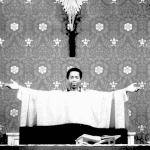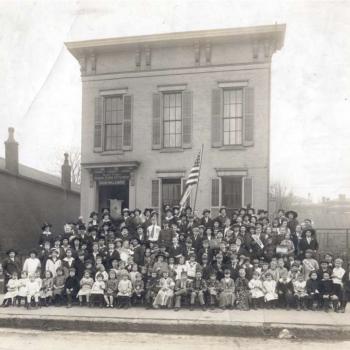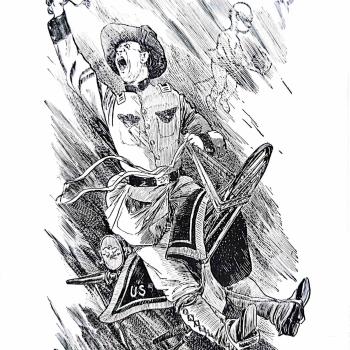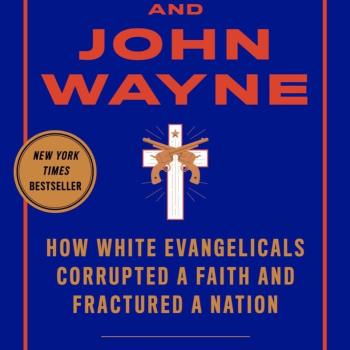For 9 years now, nearly every semester I have taught a survey course on the second half of American history. The story line is so deeply embedded in my brain that I could spontaneously regale you with nearly any lecture from this course. I have sometimes spontaneously regaled my friends with pieces of the narrative over lunch. I am grateful they are still my friends.
American history is therefore the lens through which I see the present. As each new weird thing has happened over the last few months of the coronavirus crisis, I’ve thought, “Oh, this is like that time in American history when….”
The most obvious, of course, is the flu epidemic of 1918. But I’ve actually never taught about that, so I’ve been learning about it along with everyone else. It’s therefore other aspects of our situation that have jumped out at me.
Here are some examples:
- The U.S. unemployment rate may be approaching 20%. Comparison: Previous economic depressions and recessions. Peak unemployment rate in the Great Depression of the 1930s was 25%. But from 1931 to 1940 it never dropped below 14%. The Panic of 1893 was about half as bad. At that time, unemployment exceeded 25% in parts of the country, and an overall recession of around 12% unemployment lasted for 5 years. The Great Recession of 2008 was also bad—and still vivid in our memory—but milder still. Unemployment stayed at 8-10% for four years, and then recovered.
- I can’t get the products I want when I want them. First comparison: the World Wars. I love showing students all of the
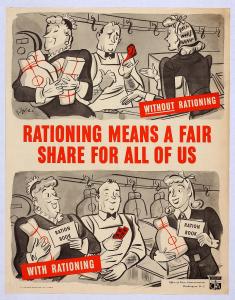
Office of Price Administration // Public Domain propaganda posters from World War I. One of my favorites announces “Eat More Cottage Cheese!” The point was that if you got your protein from dairy, you saved more meat for the troops. I hate cottage cheese, so this would have been a real sacrifice for me. Multiple items were rationed during World War II, including gasoline, tires, sugar, coffee, meat, cheese, and milk. Gasoline was rationed to 3 gallons a week. I couldn’t get to work and back home every day on 3 gallons a week (before our shelter-in-place!). Second comparison: the 1970s. Speaking of gas, not only did prices skyrocket in the 1970s, but sometimes it simply couldn’t be had at any price. You know, like toilet paper.
- The government is restricting my freedom of movement. Comparison: the draft (World War I, World War II, Korea, Vietnam). Only since the end of the conflict in Vietnam (so named because Congress never approved a formal declaration of war!) has the United States relied on an all-volunteer armed forces. And of course the federal government retains the right to reinstitute the draft if needed. One of the things that has struck me recently is that so many current pro-reopening protestors identify with the political right, but their closest historical counterparts are…the draft-card-burning hippies of the 1960s. Speaking of which, more Americans have now died of the coronavirus than in combat in Vietnam.
Now no time in history is exactly like any other time. Thus, the Great Depression cannot teach us exactly what to do economically in the present because many variables are different. But that doesn’t mean the past has nothing to teach us.
Indeed, much of what we know about the effectiveness of social distancing and subsequent economic recovery comes from the 1918 flu outbreak. We cannot translate the lessons exactly: one hundred years later, Americans are connected in all sorts of different ways and our economy is different too. But perhaps our ancestors would be at least somewhat comforted to know that their suffering nevertheless bequeathed to us some wisdom and direction in the present.
We have one other thing in common with all Americans who lived through past epidemics, recessions, and wars: we did not expect this. I try to drill into my students that they should consider when voting for President the person’s approach to both domestic and foreign policy and the person’s choice for Vice President. Because you never know what is going to happen over the course of four years. Presidents elected for their domestic agendas ended up heading a wartime nation. Presidents died early in their term and their Vice President took over. I will never have to sell this point again.

Or will I? These comparisons with the past suggest an encouraging pattern: this too shall pass. It might be bad for a long time. Individually we might suffer a permanent reduction in our fortunes, or even die young. But the country as a whole has suffered equally bad things in the past and come through it, and likely will again.
I have only just reached the point when almost none of my students can remember 9/11. And a friend pointed out to me that I will not yet have reached retirement age when almost none of my students will remember this pandemic.
I don’t know what the future holds. It could be bad. The Great Depression and World War II, 1930–1945, are years I would not want to have lived through. I very much hope 2020–2035 do not mirror them. But either way, I take comfort from the fact that it is likely that in 2040 I will be explaining the impact of COVID-19 to a freshman class who knows it only as history.



